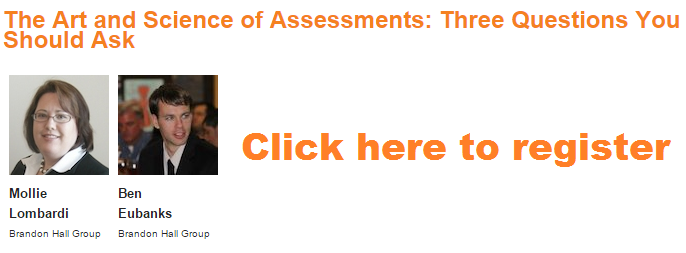 I’ve been working as an HR analyst for about a year now. Several of my friends, both in HR and out, have asked me lately what my days look like. I wanted to take a moment to highlight what it is and what it is not. I’ll also say that this is my experience. It’s certainly different for different people at different organizations. Did I mention it’s different? :-)
I’ve been working as an HR analyst for about a year now. Several of my friends, both in HR and out, have asked me lately what my days look like. I wanted to take a moment to highlight what it is and what it is not. I’ll also say that this is my experience. It’s certainly different for different people at different organizations. Did I mention it’s different? :-)
Even my coworkers that do very similar work as talent management analysts, learning analysts, and workforce management analysts have different schedules, projects, etc. I know there aren’t a significant number of HR analyst jobs out there, but for those that might be interested, this is a good peek behind the curtain.
A sample HR analyst job description
First of all, the things I spend most of my time on are briefings, research, writing, and editing. I publish all of the blogs and case studies, which is fun to get to see the full spectrum of what we do. Each day is different, of course, and I break down some of those aspects below.
Little man is still not sleeping through the night consistently yet, so when he wakes up at 4:30 I just get to work after feeding him.
- Up between 4:30 and 5:30, work to 6:15 on email and any high priority work. This is the time to plan my day.
- 6:15-7:30 Kids! Family! Craziness! I help get Melanie and the kids out the door, then I drop off little man at the sitter’s before heading back home to jump into the workday full speed.
- 7:30-10:00 Typically catch up on email, work on case studies, editing briefing reports, or writing. Most of our internal company meetings are in the morning as well.
- 10:00-10:30 Break! I’ll usually do something to break up my day, whether it’s calling a friend, squeezing in a quick workout, or going for a run to clear my head. I can’t work in long blocks without losing focus. Also, while I’m working out I often have some of my best ideas for writing or solving problems I’m working on, so this is critical to me being productive long term.
- 11:00-11:30 Eat lunch. While I eat I’ll do some reading and research to catch up on what’s going on in the industry. I sometimes use this space to reply to emails and plan my calendar for the next few days to be prepared for any big meetings, etc.
- 11:30-2:00 Back to work. I like to use my time after lunch when I’m typically at my “low” for creativity and focus to do things like making contact with HR pros to set up briefings and trying to work on any outstanding emails.
- 2:00-4:30 By this time I’m past the midday “slump” and am in prime gear to do some writing. This is when I typically create marketing copy, write my Brandon Hall Group blog posts, and do any “major” editing work that requires significant brainpower.
- Melanie usually gets home with the kids between 4:00 and 5:00 and that signals the end of the workday for me. There are some nights where I pick back up again around 8:30-9:30 if I have something pressing, my wife has to grade papers or do lesson plans, and all the kids are in bed.
Now, I know that’s just an average, so here is a breakdown of some of the actual work I get to do. As you might expect, necessary skills for an HR analyst are heavily weighted toward writing, editing, research, and data analysis.
- Meetings: internal meetings average about 30-60 minutes per day, spanning topics like research, marketing, and technology.
- Briefings: I spend time talking with HR leaders to learn what’s going on in their world and to stay plugged in. This is one of my favorite parts of my role. And talking shop with HR pros and calling it work just seems unfair. :-)Â I also host all of our vendor briefings. And while sometimes it’s a chore to fit them in, I have always been a bit of a technology nerd, so finding out what is the latest and greatest in learning, recruiting, or HR is a lot of fun.
- Case studies: Ever wonder how Hilton runs its learning program or how multimillion dollar security firms hire their staff? I did, too. And now I know, because I get to publish case studies from those companies that describe exactly how they approached the problems and solved them. Here’s a recent blog post on the Brandon Hall Group blog where I talk about them.
- Blogging: I get to blog! It’s a blast. As you can tell I love the blogging format, so this is just one more opportunity to share my thoughts. More importantly, I love the conversations it opens up to talk about what others are interested in–I certainly don’t have all of the answers. I have about 20 drafts in varying stages right now (some of which I’ll probably never actually write, funny enough) on a variety of topics, from recruitment marketing to technology selection to metrics and more.
- Research webinars: this year I picked up a new role and am hosting our research webinars with various analysts on the team. It’s a chance to share the latest and greatest research, and I like the opportunity to get in front of our great audience over there. (info on those webinars, if you’re interested)
- Attending events: a minority of my time is spent traveling and attending events. With a 5 month old at home this is something I’m thankful for. I do love getting to go to great events like the HR Technology Conference and other vendor-focused ones, but I don’t get out very much. I have a total of about 4-5 trips this year at my last count. As the kids get a bit older I expect to do more of this but not a crazy amount.
- Speaking: I speak occasionally and these are honestly the best types of events for me. I like getting to wear multiple hats. I’ll actually be presenting at SHRM this summer in Las Vegas (anyone else going? I’d love to meet you!) and the Alabama SHRM conference as well. Again, I don’t put in many applications for speaking because I don’t travel a significant amount, but I always enjoy the opportunity. When I speak I usually spend anywhere from 5-10 hours gathering information, developing slides, etc.
- Informal research: I am a Feedly fiend. I have it open any time I have 5-10 minutes to spare, because I’m always reading other blogs to gather insights and information. It’s amazing how often this inspires me to write something myself, even if the blog I’m reading is focused on design, marketing, or travel. At least half of those drafts I mentioned above started when I read a blog post or news article somewhere else.
5Â surprising things about working from home as an HR analyst
This whole “working from home” thing is a bit of what I expected, but it’s also different in other ways. Here are five things I didn’t expect:
- Nobody seems to understand that in some ways working from home is harder than working in an office. None of your friends asks to “swing by” or if you can do an errand for them when you work in an office setting. Thankfully that was short-lived, but it happens.
- It can be hard to “turn off.” When I worked in an office I had the drive home to decouple from work and shift gears. Now if the family gets home and I’m in the middle of writing or editing I have to suddenly shut everything off mentally and it can be tough to do that.
- I have more time. I’m not spending 2+ hours driving daily, and that means I can get more accomplished instead of commuting, getting to work after spending almost an hour in traffic, trying to dodge “that” talkative coworker, etc.
- I have less time. :-) I feel like with the additional time I can do more things and take on more tasks, even when it’s not really possible. That can be tough to deal with at times because I like to run in a hundred directions at once.
- Some people warned me that I would be “bored” or that I would miss working with people. While I do miss some face to face interactions with friends, I am actually well-suited to working remotely and solo. I can spend all day without turning on the radio, TV, or anything else. The days when I don’t have calls scheduled I can go for up to 9 hours without saying or hearing a single word, which is pretty peaceful. This certainly isn’t for everyone, but it’s something I think is very interesting to know. I’m a natural introvert and talking a lot and interacting with people can be draining for me at times.
HR analyst salary information
Information about a human resources analyst salary is all over the map. I think that’s due in part to the fact that some companies are loose in defining what an analyst is/does, so that means the job duties can range (and pay naturally follows). Here are a few resources for details on what an HR analyst makes. As you’ll see, it can vary wildly.
Human resource analyst job openings
As I said above, the type of analyst work I’m doing is reserved typically for very large companies, vendors, or research/consulting firms. Other names for this type of role (if you’re searching for an HR analyst position) that could be helpful:
- human resources analyst
- talent management analyst
- talent acquisition analyst
- learning analyst
- workforce management analyst
- principal analyst
- senior analyst
- associate analyst
- business analyst
- HCM analyst
- human resource analyst
So, what else do you want to know, whether it’s about this whole “working from home” or the HR analyst role? I’d love to answer questions if you have any!
 I’ve been working as an HR analyst for about a year now. Several of my friends, both in HR and out, have asked me lately what my days look like. I wanted to take a moment to highlight what it is and what it is not. I’ll also say that this is my experience. It’s certainly different for different people at different organizations. Did I mention it’s different? :-)
I’ve been working as an HR analyst for about a year now. Several of my friends, both in HR and out, have asked me lately what my days look like. I wanted to take a moment to highlight what it is and what it is not. I’ll also say that this is my experience. It’s certainly different for different people at different organizations. Did I mention it’s different? :-)
 One of the best conversations I had last week was about how technology is changing to allow internal HR/recruiting leaders to also take over the management of contingent workers: free agents, temps, etc. But, if you’ve spent some time in HR, you probably know that this is something that we just don’t do. But why?
One of the best conversations I had last week was about how technology is changing to allow internal HR/recruiting leaders to also take over the management of contingent workers: free agents, temps, etc. But, if you’ve spent some time in HR, you probably know that this is something that we just don’t do. But why?